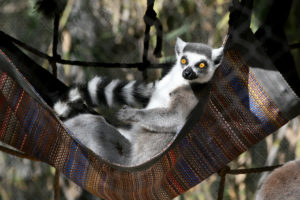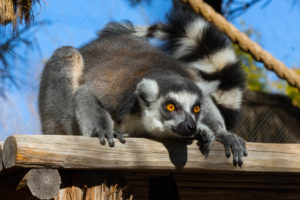Meet the ring-tailed lemurs with the animal experts!
Move it, move it over to meet Reid Park Zoo’s new ring-tailed lemurs – Elm, Oak, and Linden. At a special after hours event 5-6:30 p.m. Wednesday, February 22, guests will have the opportunity to get to know these three male lemurs with Zoo Supervisor, Leslie Waters. Guest speaker Stacey Tecot, from U of A School of Anthropology, will present about lemurs in Madagascar and efforts to help this endangered species.
Stacey also took the time to do a quick Q & A so you can learn more about these lemurs!
What do you think is most unique about ring-tailed lemurs?
There is a lot that is unique about ring-tailed lemurs! On first inspection it’s hard to miss their long, beautiful, striped tails. They use these tails in part to communicate with each other. They will rub the scent glands on their wrists on their tails and then waft them in the air at each other during ‘stink fights’, or to communicate to a potential mate that they are interested. They are also female dominant, meaning that females have priority over food and space, they can be aggressive towards males, and males are spontaneously deferential to them.

What can someone living in Southern Arizona do to help lemurs in the wild?
The Lemur Conservation Network and the Reid Park Zoo website are a good place to start and learn more about lemurs, organizations working to help protect them, and ways to help through donations, volunteering in Madagascar, or even volunteering from home. Visiting Madagascar helps the economy, which impacts natural resources–and it’s a beautiful place to visit! One might also organize or participate in various fundraising events. If none of that seems possible, just spreading the word is very helpful!
It’s also helpful and relatively easy to be a good consumer. Threats to lemurs include the illegal logging of rosewood, which makes its way to the US and other countries. People in Madagascar benefit the least from illegal logging, while other countries can make quite a bit. That activity also increases pressure on the lemurs because poorly paid workers may eat bushmeat (threatened lemur species). We unknowingly purchase these items, so it’s always important to ask where your wood products come from.
What is something you want people to know about lemurs or about wildlife
in Madagascar?
Lemurs are unique among primates for many reasons, in part because they are restricted to the island of Madagascar. The majority of plants and animals on Madagascar exist nowhere else in the world. Since lemurs as a group are highly threatened, we risk losing this diversity, and the ability to learn from it. For example, many plants in Madagascar have medicinal properties. One, the rosy periwinkle, greatly increases the chances of surviving childhood Leukemia and helps treat Hodgkins’ disease.

How do you think people can get even closer to these animals?
If taking a trip to Madagascar is out of the question, visit Reid Park Zoo! Take some time to watch them for a while, because they have so many different behaviors in their repertoire that you might miss if you just glance. Also, there are many documentaries and books that give a wonderful sense of what it is like to be there among the lemurs. I especially like “Madagascar” narrated by David Attenborough. “Mammals of Madagascar” is a beautiful book by Nick Garbutt, and “The Eight Continent: Life, Death, and Discovery in the Lost World of Madagascar” by Peter Tyson was one of my favorites when I was living in Madagascar. A few books by leading primatologists are good reads as well: “Lords and Lemurs” and “Thank you, Madagascar” by the late Allison Jolly, and “For the Love of Lemurs” by Patricia Wright.
